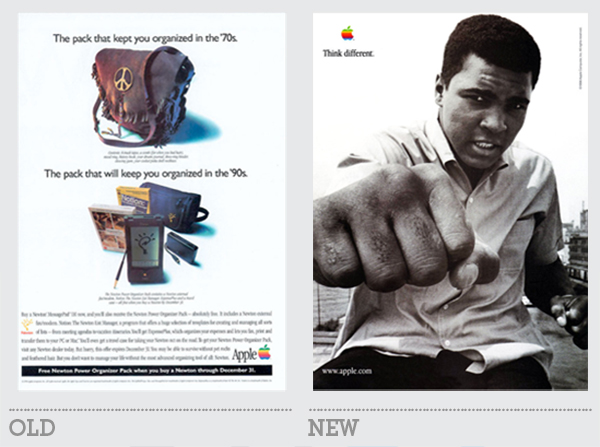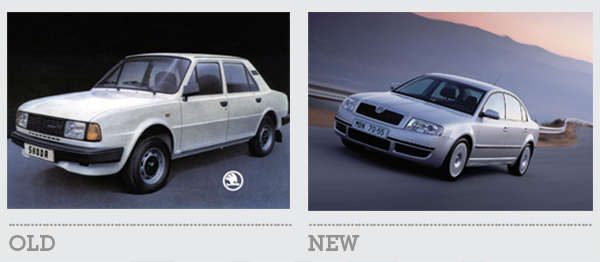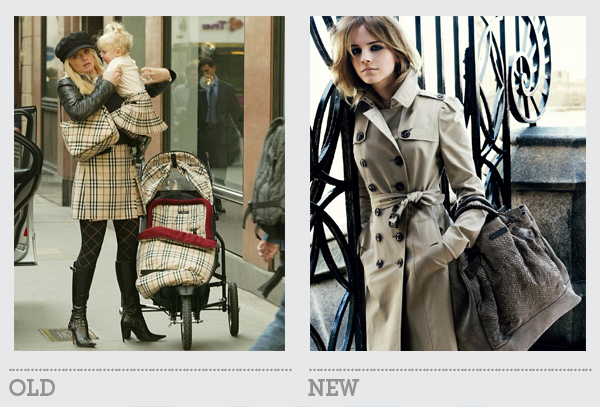As a brand consultancy we are often approached by clients who are considering a rebrand of their company. There are a number of reasons for wanting to rebrand but doing so without the right motivation and consideration can often do more harm than good.
We recently posted an article on major rebrands that failed and a lot can be learned from looking at companies that didn’t engage with the exercise correctly and got it wrong. Of course there is just as much to be gained from looking at those who succeeded and recognising why the process worked. These instances are less about redesigned logos and more about revamped images; examples of big companies successfully changing the public’s perception of their brands:

Where better to start than with the world’s most recognisable and influential brand – Apple. Many of the consumers currently enamoured with the company’s carefully crafted tech ecosystem will be unaware of the mess Apple was in during the mid 1990s. It was in such disarray that it was very nearly bought out by its rival Microsoft.
Then, in a fairytale turn of events, Steve Jobs returned to the company he had built and turned it around. He overhauled the Apple brand and implemented a process of streamlining, restructuring and astute marketing. Most significantly, he hired the advertising agency TBWA Chiat/Day with whom he created one of the greatest advertising campaigns of all time – Think Different. ‘Apple the outsider’ became ‘Apple the free-thinker’; a return to being the revolutionary icon of the counter-culture it had been in the 70s and early 80s. It was the start of Apple crafting itself as a lifestyle company, rather than a tech company. Throw in the launch of the iMac three years later and this is arguably the greatest turnaround in branding history.

Following on from Apple is its long-standing rival, Microsoft. The fortunes of Bill Gates’s company was the inverse to that of Apple’s. All powerful in the 80s and 90s, by the turn of the new century it was starting to fall apart. Unable to keep up with the strident technological advances of the reborn Apple and the upstart Google, it suffered from poor marketing, declining popularity and legal issues that cost it millions in monopoly litigation. Even its singular success, the X-Box wasn’t enough to halt the slide.
With the release of Windows Phone 7, though, the company began a gradual rebrand bringing all of its touch points in line with the design of its software system, Metro. In fact, Microsoft embraced the currently in-vogue flat icon aesthetic long before the usually trail-blazing Apple, who clung onto its skeuomorphic design style well past its sell-by date. Microsoft eventually overhauled all of its brands, unifying all the disparate elements with flat bold colours and a consistent simple font. Whilst not the revolution that Apple underwent, the expansive rebrand has helped Microsoft regain a lot of the ground it lost in the previous decade.

Reputation is everything. No matter what the quality of its products or services, if a company is negatively perceived it is incredibly difficult to counteract. Which is what makes Skoda’s rebranding so impressive. In the 1980s, Skoda was the butt of many, many jokes (What do you call a Skoda with two exhausts? A wheelbarrow). But in 1991, Volkswagen, a car manufacturer that is very brand conscious, bought a stake in the ailing company. VW immediately implemented a raft of changes including a new factory and training for assembly workers. The new models launched in 1994 (Felicia) and 1998 (Octavia) were well received by car reviewers and the company appeared to be on an upswing.
But the cars still didn’t sell. It wasn’t enough to have the backing of VW and a well regarded product – Skoda needed something more to overcome the entrenched stigma generated by years of jokes. So they hit back with a brand and marketing campaign that riffed on the very idea of Skodas being badly perceived. The main thrust of the campaign – So good you won’t believe it’s a Skoda – helped to alter the perception of the new models. People responded to the tongue-in-cheek advertising and before long the word of mouth about the actual cars became positive. The campaign resulted in a 34% increase in sales and led, over the next decade, to an almost complete reversal of the brand’s poor perception.

As with Skoda, Burberry’s reputation in the late 1990s was hugely damaged. But in their case their brand had become highjacked by a public perception that ran counter to its heritage and equity. Despite being a luxury fashion brand, Burberry became synonymous with gang culture and hooliganism – so much so that even wearing Burberry’s trademark tartan clothes could get you banned from pubs and clubs.
The problem was that Burberry had overextended their reach, weakening the equity of their brand by slapping their designs on too many products – caps, umbrellas and even buggy covers. At a time when ‘chavs’ were emerging as the demon element of society, Burberry’s tartan was their uniform. A change in creative director in 2001 signalled a change in direction, refocusing the brand into a reduced product range of designer items, and a return to marketing their luxury and exclusivity. Partnered with astute advertising in high-end fashion magazines featuring well-chosen celebrities like Kate Moss and Emma Watson, Burberry was able to take back its heritage and reclaim its place as a luxury fashion label.

By the late 1990s, the grand old dame of the UK high street was struggling. Complaints of low quality goods, poor clothing ranges and the peculiar refusal to accept credit cards left its reputation in tatters and many believed it would be taken over or close down altogether. A radical overhaul was required and that’s exactly what happened. Centred around a revised name and new logo, Marks and Spencer changed almost every touch point, from shop refits and upmarket designer clothing ranges to stylish new bags and even redesigned till receipts. Coupled with this was the company’s first foray into television advertising with two campaigns; one for the new clothing line-up featuring Myleene Klass, Twiggy, Elisabeth Jagger and Noemie Lenoir; the other for their revitalised food range with adverts that worked so well they have since become frequently imitated and occasionally satirised. All of this helped M&S to compete again in the retail marketplace and regain its reputation on the high street.